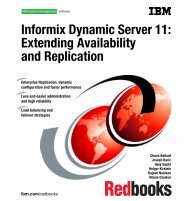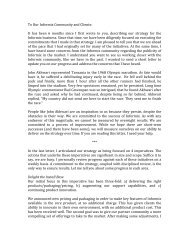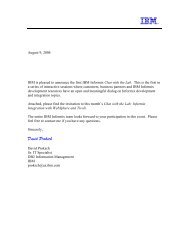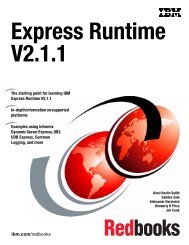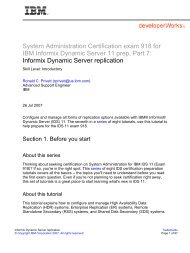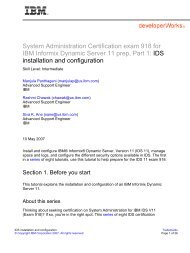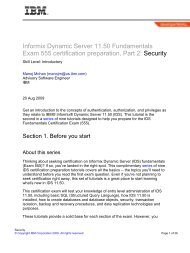Hyun-Ju Vega - Understanding Optimizer Statistics in Cheetah
Hyun-Ju Vega - Understanding Optimizer Statistics in Cheetah
Hyun-Ju Vega - Understanding Optimizer Statistics in Cheetah
Create successful ePaper yourself
Turn your PDF publications into a flip-book with our unique Google optimized e-Paper software.
<strong>Understand<strong>in</strong>g</strong> <strong>Optimizer</strong><br />
<strong>Statistics</strong> <strong>in</strong> <strong>Cheetah</strong><br />
<strong>Hyun</strong>-<strong>Ju</strong> <strong>Vega</strong><br />
IBM<br />
Session D10<br />
Tuesday, April 29, 2008 • 02:10 p.m. – 03:10 p.m.<br />
2008 IIUG Conference<br />
2008 IIUG<br />
1
2008 IIUG Informix Conference<br />
The Power Conference<br />
For Informix Professionals<br />
What’s New <strong>in</strong> <strong>Cheetah</strong>?<br />
• Create Index statement now automatically gathers<br />
statistics for the newly created <strong>in</strong>dex<br />
• Real-time Temp Table <strong>Statistics</strong><br />
• Enhanced Catalog Info for Update <strong>Statistics</strong><br />
• Improved Set Expla<strong>in</strong> -- Query <strong>Statistics</strong> <strong>in</strong> Set<br />
Expla<strong>in</strong> Output<br />
• Enhanced Update <strong>Statistics</strong> Support for Large Tables<br />
< 2 ><br />
F<strong>in</strong>d out how you can get the most out of the new optimizer statistics features<br />
<strong>in</strong> <strong>Cheetah</strong> by understand<strong>in</strong>g what's new and different <strong>in</strong> IDS 11.10. This<br />
presentation is a survey of new auto-statistics and update statistics related<br />
features <strong>in</strong> IDS 11. It describes the new functionalities <strong>in</strong> detail and discusses<br />
how the new statistics features <strong>in</strong> <strong>Cheetah</strong> may affect current update statistics<br />
practices and performance.<br />
Topics discussed <strong>in</strong>clude the new auto-statistics feature when creat<strong>in</strong>g<br />
<strong>in</strong>dexes, real-time temp table statistics, enhanced catalog <strong>in</strong>formation for<br />
update statistics data, the new "Sampl<strong>in</strong>g Size" option <strong>in</strong> Update <strong>Statistics</strong><br />
Medium command, and the improved Set Expla<strong>in</strong>.<br />
2
2008 IIUG Informix Conference<br />
The Power Conference<br />
For Informix Professionals<br />
Quick Review of the Optimization Process -- Why<br />
is statistics important?<br />
• Choos<strong>in</strong>g the right QUERY PATH<br />
determ<strong>in</strong>es how fast you get your<br />
results.<br />
• Choos<strong>in</strong>g the Wrong Path can be<br />
like go<strong>in</strong>g around the world to get<br />
to your neighbor’s.<br />
► Expensive to go<br />
around the world.<br />
► Takes too long.<br />
< 3 ><br />
A query path is the method the optimizer uses to form tuples (the results of a<br />
jo<strong>in</strong> between two tables). The optimizer uses cost estimates to determ<strong>in</strong>e the<br />
optimal query path to use. Each path is assigned a cost estimate based on a<br />
formula; the cheapest path is considered the optimal path.<br />
A good query path can m<strong>in</strong>imize the amount of data that will be exam<strong>in</strong>ed.<br />
The more you can narrow down the number of possible rows that satisfy the<br />
query <strong>in</strong> the earlier stages, the less time is spent read<strong>in</strong>g rows <strong>in</strong> other tables<br />
that may not match the query criteria. This is why very small tables, or tables<br />
with very restrictive filters (example: order_num = 1001), are usually put early<br />
<strong>in</strong> the query path.<br />
A good query path can also prevent extra sort<strong>in</strong>g for ORDER BY or GROUP<br />
BY statements. For example, to prevent an ORDER BY <strong>in</strong> a SELECT<br />
statement from requir<strong>in</strong>g a sort, the optimizer may choose to put the table<br />
conta<strong>in</strong><strong>in</strong>g the sort columns first (assum<strong>in</strong>g there is an <strong>in</strong>dex on the sort<br />
columns and the nested loop jo<strong>in</strong> is used for subsequent jo<strong>in</strong>s). S<strong>in</strong>ce the<br />
table will be scanned <strong>in</strong> the order of the column specified <strong>in</strong> the ORDER BY,<br />
no extra sort process is needed.<br />
3
2008 IIUG Informix Conference<br />
The Power Conference<br />
For Informix Professionals<br />
Query Optimization Process<br />
• Exam<strong>in</strong>e all tables (table A, table B, table C)<br />
• Exam<strong>in</strong>e selectivity of every filter (where clauses)<br />
• Determ<strong>in</strong>e if <strong>in</strong>dexes can be used for filters, order by, group by<br />
• F<strong>in</strong>d the best way to scan a table -- sequentially or by an <strong>in</strong>dex<br />
• Identify Jo<strong>in</strong> Pairs (AB, AC, BA, BC, CA, CB)<br />
• F<strong>in</strong>d best jo<strong>in</strong> method (nested loop, hash, or sort merge)<br />
• Decide which <strong>in</strong>dexes are best for the jo<strong>in</strong><br />
• Calculate the cost of the jo<strong>in</strong><br />
• Repeat for each additional table (ABC, ACB, BAC, ...)<br />
< 4 ><br />
4
2008 IIUG Informix Conference<br />
The Power Conference<br />
For Informix Professionals<br />
Estimat<strong>in</strong>g costs ** -- Need data!<br />
• F<strong>in</strong>d the cheapest/lowest cost path.<br />
• Cost = I/O cost + Weight * (CPU cost)<br />
• I/O -- disk access<br />
• CPU -- Rows processed<br />
• Estimate costs<br />
• Filters -- Which <strong>in</strong>dexes to be used?<br />
• Jo<strong>in</strong>s -- Nested Loop, Hash, or Sort Merge?<br />
• Elim<strong>in</strong>ate redundant pairs?<br />
< 5 ><br />
The three basic strategies for jo<strong>in</strong><strong>in</strong>g two tables -- nested loop jo<strong>in</strong>, hash jo<strong>in</strong>s,<br />
sort merge jo<strong>in</strong>.<br />
In a nested loop jo<strong>in</strong>, the first table is scanned, and the results are matched to<br />
the correspond<strong>in</strong>g columns <strong>in</strong> the second table. The process would work<br />
someth<strong>in</strong>g like this -- fetch a from the first table, use the jo<strong>in</strong> column(s) to<br />
search for rows <strong>in</strong> the second table that have match<strong>in</strong>g jo<strong>in</strong> column values.<br />
In a sort merge jo<strong>in</strong>, both tables are scanned <strong>in</strong> the order of the jo<strong>in</strong> filter. It<br />
would work someth<strong>in</strong>g like this -- sort each table by the jo<strong>in</strong> column, then<br />
merge the rows from each table <strong>in</strong>to the result<strong>in</strong>g jo<strong>in</strong> tuples.<br />
In a hash jo<strong>in</strong>, a sequential scan of the first table is done to build a hash table,<br />
then rows from the second table are looked up <strong>in</strong> the hash table to create<br />
tuples. Typically, the hash table is created on the smaller table. Hash jo<strong>in</strong>s<br />
can be faster than the other jo<strong>in</strong> methods, especially where the size of the jo<strong>in</strong><br />
tables are very large.<br />
5
2008 IIUG Informix Conference<br />
The Power Conference<br />
For Informix Professionals<br />
Filter selectivity assignments<br />
• Selectivity is the percentage of rows selected as a result<br />
of a filter (number between 0 and 1)<br />
Example:<br />
Expression<br />
<strong>in</strong>dexed_col = literal value<br />
<strong>in</strong>dexed_col > literal value<br />
NOT expression<br />
expr1 AND expr2<br />
Filter Selectivity<br />
F=1/(number of dist<strong>in</strong>ct keys <strong>in</strong> <strong>in</strong>dex)<br />
F = (literal value - 2 nd m<strong>in</strong>)/(2 nd max-2 nd m<strong>in</strong>)<br />
F = 1 - F(expression)<br />
F = F(expr1) x F(expr2)<br />
< 6 ><br />
Selectivity is a number between 0 and 1 -- closer to 0, more selective.<br />
Look at what k<strong>in</strong>ds of data are needed to figure out how selective a filter is --<br />
number of dist<strong>in</strong>ct keys <strong>in</strong> an <strong>in</strong>dex, 2 nd m<strong>in</strong>, 2 nd max, etc.<br />
6
2008 IIUG Informix Conference<br />
The Power Conference<br />
For Informix Professionals<br />
How do we Influence Query Optimization?<br />
• OPTCOMPIND<br />
• <strong>Optimizer</strong> directives (Optimization Goals)<br />
• <strong>Statistics</strong> (Update <strong>Statistics</strong>) ***<br />
• Collect <strong>in</strong>formation for the optimizer<br />
• <strong>Statistics</strong> -- Update <strong>Statistics</strong> LOW<br />
• Distributions -- MEDIUM & HIGH<br />
• Drop distributions<br />
• Compile Stored Procedures<br />
< 7 ><br />
OPTCOMPIND -- ONCONFIG parameter (default is 2); environment variable.<br />
2 -- The optimizer bases its decision purely on costs, regardless of transaction<br />
isolation mode.<br />
0 -- Use <strong>in</strong>dex if available; give preference to nested-loop jo<strong>in</strong> (don’t do hash<br />
jo<strong>in</strong>s).<br />
1 -- Behave like 0 if isolation level is Repeatable Read; otherwise, behave like<br />
2.<br />
<strong>Optimizer</strong> directives:<br />
Example: SELECT {+INDEX(emp idx_dept_no)} ... ;<br />
Optimization goals (ALL_ROWS -- optimize for the total execution time of the<br />
query -- or FIRST_ROWS)<br />
Example:<br />
OPT_GOAL ONCONFIG parameter<br />
OPT_GOAL env. variable.<br />
SET OPTIMIZATION FIRST_ROWS;<br />
7
2008 IIUG Informix Conference<br />
The Power Conference<br />
For Informix Professionals<br />
Update <strong>Statistics</strong> Low Basic Algorithm<br />
• Walk the leaf pages <strong>in</strong> each <strong>in</strong>dex<br />
• Submit btree cleaner requests when deleted items<br />
are found caus<strong>in</strong>g <strong>in</strong>dexes to be re-balanced<br />
• Collects the follow<strong>in</strong>g <strong>in</strong>formation<br />
• Number of unique items<br />
• Number of leaf pages<br />
• How clustered the data is<br />
• Second highest and lowest value<br />
< 8 ><br />
8
2008 IIUG Informix Conference<br />
The Power Conference<br />
For Informix Professionals<br />
Update <strong>Statistics</strong> Basic Algorithm<br />
for Medium and High<br />
• Develop scan plan based on available resources<br />
• Scan table<br />
• High ----> All rows<br />
• Medium ----> Sample of rows<br />
• Sort each column<br />
• Build distributions<br />
• Beg<strong>in</strong> transaction<br />
• Delete old columns distributions<br />
• Insert new columns distributions<br />
• Commit transaction<br />
< 9 ><br />
9
2008 IIUG Informix Conference<br />
SQEXPLAIN Output<br />
QUERY:<br />
------------<br />
select * from t1 where c1 > 20200<br />
Estimated Cost: 20888<br />
Estimated # of Rows Returned: 6760<br />
1) <strong>in</strong>formix.t1: SEQUENTIAL SCAN<br />
Filters: <strong>in</strong>formix.t1.c1 > 20200<br />
The Power Conference<br />
For Informix Professionals<br />
c1 is a serial column,<br />
and there are 20280<br />
rows <strong>in</strong> the table.<br />
Th<strong>in</strong>gs to consider:<br />
Does the number of<br />
estimated rows returned<br />
for the query make<br />
sense?<br />
Does the access method<br />
make sense?<br />
Update <strong>Statistics</strong> -- The better the <strong>in</strong>formation,<br />
the more accurate the estimate.<br />
< 10 ><br />
Sequential scans can consume a large quantity of resources so validate that they are<br />
appropriate<br />
Sequential scans are appropriate if most or all of the table rows are be<strong>in</strong>g returned<br />
Example: Update <strong>Statistics</strong> will do sequential scans<br />
If only a small percentage of the rows are be<strong>in</strong>g returned (but a sequential scans are be<strong>in</strong>g<br />
done), then this <strong>in</strong>dicates that you may need better <strong>in</strong>dexes on the table(s).<br />
F<strong>in</strong>d all tables do<strong>in</strong>g sequential scans hav<strong>in</strong>g a size greater than 100 pages:<br />
select dbsname, tabname ,<br />
pf_seqscans , npdata, npused<br />
from sysptntab, systabnames, sysptnhdr<br />
where pf_seqscans > 0<br />
and sysptnhdr.npdata > 100<br />
and sysptnhdr.npused > 100<br />
and sysptnhdr.partnum = systabnames.partnum<br />
and systabnames.partnum = sysptntab.partnum<br />
order by pf_seqscans DESC<br />
10
2008 IIUG Informix Conference<br />
The Power Conference<br />
For Informix Professionals<br />
Update <strong>Statistics</strong> Example<br />
• No <strong>Statistics</strong> vs Medium <strong>Statistics</strong><br />
QUERY:<br />
------------<br />
select * from t1 where c1 > 20200<br />
Estimated Cost: 20888<br />
Estimated # of Rows Returned: 6760<br />
1) <strong>in</strong>formix.t1: SEQUENTIAL SCAN<br />
Filters: <strong>in</strong>formix.t1.c1 > 20200<br />
QUERY:<br />
------------<br />
select * from t1 where c1 > 20200<br />
Estimated Cost: 21<br />
Estimated # of Rows Returned: 19<br />
1) <strong>in</strong>formix.t1: INDEX PATH<br />
(1) Index Keys: c1 (Serial,fragments: ALL)<br />
Lower Index Filter: t1.c1 > 20250<br />
• Query plan changed to Index Path for Medium<br />
<strong>Statistics</strong> (vs No <strong>Statistics</strong>), huge improvement <strong>in</strong><br />
estimated cost and estimated number of rows<br />
(actual number of rows returned is 30)<br />
< 11 ><br />
11
2008 IIUG Informix Conference<br />
The Power Conference<br />
For Informix Professionals<br />
Update <strong>Statistics</strong> Example<br />
• Medium vs High <strong>Statistics</strong><br />
QUERY:<br />
------------<br />
select * from t1 where c1 > 20200<br />
Estimated Cost: 21<br />
Estimated # of Rows Returned: 19<br />
1) <strong>in</strong>formix.t1: INDEX PATH<br />
(1) Index Keys: c1 (Serial,fragments: ALL)<br />
Lower Index Filter: t1.c1 > 20250<br />
QUERY:<br />
------------<br />
select * from t1 where c1 > 20200<br />
Estimated Cost: 33<br />
Estimated # of Rows Returned: 30<br />
1) <strong>in</strong>formix.t1: INDEX PATH<br />
(1) Index Keys: c1 (Serial,fragments: ALL)<br />
Lower Index Filter: t1.c1 > 20250<br />
• Query plan did not change, and there is no<br />
significant change <strong>in</strong> performance.<br />
< 12 ><br />
12
2008 IIUG Informix Conference<br />
The Power Conference<br />
For Informix Professionals<br />
Why Improve Create Index?<br />
• Customers have to run UPDATE<br />
STATISTICS LOW at a m<strong>in</strong>imum for newly<br />
created <strong>in</strong>dexes to be considered for query<br />
access plans.<br />
• Customers are recommended to run<br />
UPDATE STATISTICS on table immediately<br />
after they create <strong>in</strong>dex on the table.<br />
Why can’t these be done automatically<br />
when new <strong>in</strong>dexes are created?<br />
< 13 ><br />
13
2008 IIUG Informix Conference<br />
The Power Conference<br />
For Informix Professionals<br />
Create Index Change Summary<br />
• When the CREATE INDEX statement runs<br />
successfully, IDS automatically gathers the follow<strong>in</strong>g<br />
statistics for the newly created <strong>in</strong>dex:<br />
• Index-level statistics, equivalent to the statistics gathered <strong>in</strong><br />
the UPDATE STATISTICS operation <strong>in</strong> LOW mode, for all<br />
types of <strong>in</strong>dexes, <strong>in</strong>clud<strong>in</strong>g B-tree, Virtual Index Interface (VII),<br />
and functional <strong>in</strong>dexes.<br />
• Column-distribution statistics, equivalent to the distribution<br />
generated <strong>in</strong> the UPDATE STATISTICS operation <strong>in</strong> MEDIUM<br />
or HIGH mode, for a non-opaque lead<strong>in</strong>g <strong>in</strong>dexed column of<br />
an ord<strong>in</strong>ary B-tree <strong>in</strong>dex. The resolution is 1.0 for a table size<br />
that is less than 1 million rows and 0.5 for larger tables.<br />
< 14 ><br />
Implicit or explicit CREATE INDEX automatically calculates distribution<br />
statistics for the lead<strong>in</strong>g column of the <strong>in</strong>dex <strong>in</strong> HIGH mode, as well as <strong>in</strong>dex<br />
statistics and table statistics <strong>in</strong> LOW mode. This feature is always enabled --<br />
cannot turn off.<br />
The automatically gathered distribution statistics are available to the query<br />
optimizer when it designs query plans for the table on which the new <strong>in</strong>dex<br />
was created.<br />
14
2008 IIUG Informix Conference<br />
The Power Conference<br />
For Informix Professionals<br />
Important!<br />
• Please note that a separate “Update <strong>Statistics</strong>”<br />
command is not run to gather any of the<br />
statistics and distribution <strong>in</strong>fo.<br />
• The optimizer <strong>in</strong>formation is gathered dur<strong>in</strong>g the<br />
<strong>in</strong>dex build<strong>in</strong>g process -- done <strong>in</strong> an optimized<br />
way so that performance is not impacted.<br />
• Internally, we gather the same k<strong>in</strong>d of<br />
<strong>in</strong>formation as if we had run update statistics.<br />
< 15 ><br />
The optimizer <strong>in</strong>formation is gathered dur<strong>in</strong>g the <strong>in</strong>dex build<strong>in</strong>g process.<br />
Internally, we gather the same k<strong>in</strong>d of <strong>in</strong>fo as if we had run update statistics.<br />
Because this is done <strong>in</strong> an optimized way, the statistics and distribution<br />
gather<strong>in</strong>g should not impact performance -- performance should be similar to<br />
what it was previous to the new feature(s).<br />
15
2008 IIUG Informix Conference<br />
The Power Conference<br />
For Informix Professionals<br />
Example:<br />
• CREATE INDEX idx1 on tab1(b_<strong>in</strong>teger)<br />
• Automatically creates distribution and statistics for the lead<strong>in</strong>g column of the<br />
<strong>in</strong>dex (idx1)<br />
• Equivalent to runn<strong>in</strong>g UPDATE STATISTICS HIGH to create distribution for<br />
lead<strong>in</strong>g <strong>in</strong>dex (idx1) column<br />
• Equivalent to runn<strong>in</strong>g UPDATE STATISTICS LOW to update <strong>in</strong>dex (idx1) and<br />
table statistics<br />
SET EXPLAIN Output for CREATE INDEX statement:<br />
Index:<br />
idx1 on <strong>in</strong>formix.tab1<br />
STATISTICS CREATED AUTOMATICALLY:<br />
Column Distribution for: <strong>in</strong>formix.tab1.b_<strong>in</strong>teger<br />
Mode:<br />
HIGH<br />
Number of B<strong>in</strong>s: 207 B<strong>in</strong> size: 4800.0<br />
Sort data:<br />
0.9 MB<br />
Completed build<strong>in</strong>g distribution <strong>in</strong>: 0 m<strong>in</strong>utes 1 seconds<br />
< 16 ><br />
16
2008 IIUG Informix Conference<br />
The Power Conference<br />
For Informix Professionals<br />
onstat -g ses <br />
IBM Informix Dynamic Server Version 11.50.FCB4 -- On-L<strong>in</strong>e -- Up 2 days 05:20:34 -- 250944<br />
Kbytes<br />
session effective #RSAM total used dynamic<br />
id user user tty pid hostname threads memory memory expla<strong>in</strong><br />
26 <strong>in</strong>formix - 0 475376 rat-06 5 352256 338128 off<br />
tid name rstcb flags curstk status<br />
112 sqlexec 70000001031f8a0 Y-BP--- 17936 cond wait opened_up -<br />
113 mb_colle 7000000103200a8 --B---- 2016 sleep<strong>in</strong>g secs: 1 -<br />
117 xchg_1.0 7000000103208b0 Y-B---- 1760 cond wait opened_up -<br />
118 xchg_2.0 7000000103210b8 --B---- 1600 runn<strong>in</strong>g-<br />
119 xchg_3.0 7000000103218c0 --B-R-- 1648 ready-<br />
...<br />
< 17 ><br />
New thread -- mb_collector -- m<strong>in</strong>i-b<strong>in</strong> collector for collect<strong>in</strong>g distribution <strong>in</strong>fo.<br />
New memory pool <strong>in</strong> onstat -g mem -- “mb_”.<br />
17
2008 IIUG Informix Conference<br />
The Power Conference<br />
For Informix Professionals<br />
Details on distribution creation<br />
• To create distribution <strong>in</strong>formation on the lead<strong>in</strong>g column of the<br />
<strong>in</strong>dex, the CREATE INDEX statement automatically gathers<br />
statistics by sort<strong>in</strong>g the lead<strong>in</strong>g column and build<strong>in</strong>g distribution<br />
b<strong>in</strong>s from the sorted data.<br />
• The distribution <strong>in</strong>formation can be viewed us<strong>in</strong>g the<br />
“dbschema -hd” option, which displays the <strong>in</strong>formation stored<br />
<strong>in</strong> the database sysdistrib catalog table.<br />
• Although very similar to UPDATE STATISTICS HIGH, the<br />
distribution creation process is not identical to UPDATE<br />
STATISTICS HIGH.<br />
• For tables with less than a million rows, a resolution of 1 is used, so that<br />
the number of distribution b<strong>in</strong>s created is roughly 100.<br />
• For tables with more than a million rows, resolution of 0.5 is used, so that<br />
the number of distribution b<strong>in</strong>s created is roughly 200.<br />
< 18 ><br />
18
2008 IIUG Informix Conference<br />
The Power Conference<br />
For Informix Professionals<br />
Example: Distribution B<strong>in</strong> Info<br />
• dbschema -d testdb -hd all<br />
DBSCHEMA Schema Utility INFORMIX-SQL Version 11.10.FC1<br />
Copyright IBM Corporation 1996, 2007 All rights reserved<br />
{<br />
Distribution for <strong>in</strong>formix.tlrtab.b_<strong>in</strong>teger<br />
Constructed on 2007-05-29 13:42:45.00000<br />
High Mode, 0.500000 Resolution<br />
--- DISTRIBUTION ---<br />
( NULL)<br />
1: ( 4800, 4800, -2079917777)<br />
2: ( 4800, 4800, -2059740802)<br />
3: ( 4800, 4799, -2039581307)<br />
4: ( 4800, 4798, -2019086003)<br />
...<br />
205: ( 4800, 4800, 2074411864)<br />
206: ( 4800, 4799, 2094676598)<br />
207: ( 1264, 1264, 2099993300)<br />
-- number of values <strong>in</strong><br />
each b<strong>in</strong>, the number of<br />
dist<strong>in</strong>ct values <strong>in</strong> each<br />
b<strong>in</strong>, and the high value<br />
<strong>in</strong> the b<strong>in</strong><br />
--- OVERFLOW ---<br />
}<br />
1: ( 10123, NULL)<br />
-- frequency and value<br />
< 19 ><br />
19
2008 IIUG Informix Conference<br />
How to read Distributions<br />
The Power Conference<br />
For Informix Professionals<br />
# of rows represented <strong>in</strong> this b<strong>in</strong><br />
--- DISTRIBUTION ---<br />
( -1<br />
1: ( 868317, 70, 75)<br />
2: ( 868317, 24, 100)<br />
3: ( 868317, 12, 116)<br />
4: ( 868317, 30, 147)<br />
5: ( 868317, 39, 194)<br />
6: ( 868317, 28, 222)<br />
--- OVERFLOW ---<br />
1: ( 779848, 43)<br />
2: ( 462364, 45)<br />
# of unique values<br />
Highest Value <strong>in</strong> this b<strong>in</strong><br />
To get the range of values<br />
look at the highest value<br />
<strong>in</strong> the previous b<strong>in</strong>.<br />
The value<br />
# of rows for this value<br />
< 20 ><br />
20
2008 IIUG Informix Conference<br />
The Power Conference<br />
For Informix Professionals<br />
Example - Approximat<strong>in</strong>g a Value<br />
--- DISTRIBUTION ---<br />
( -1<br />
1: ( 868317, 70, 75)<br />
2: ( 868317, 24, 100)<br />
3: ( 868317, 12, 116)<br />
4: ( 868317, 30, 147)<br />
5: ( 868317, 39, 194)<br />
6: ( 868317, 28, 222)<br />
--- OVERFLOW ---<br />
1: ( 779848, 43)<br />
2: ( 462364, 45)<br />
• There are 868317 rows<br />
conta<strong>in</strong><strong>in</strong>g a value between -1<br />
and 75<br />
• There are 70 unique values <strong>in</strong><br />
this range<br />
• The optimizer will deduce<br />
868317 / 70 = 12,404 records for<br />
each value between -1 and 75<br />
< 21 ><br />
21
2008 IIUG Informix Conference<br />
The Power Conference<br />
For Informix Professionals<br />
Example - Deal<strong>in</strong>g with Data Skew<br />
--- DISTRIBUTION ---<br />
( -1<br />
1: ( 868317, 70, 75)<br />
2: ( 868317, 24, 100)<br />
3: ( 868317, 12, 116)<br />
4: ( 868317, 30, 147)<br />
5: ( 868317, 39, 194)<br />
6: ( 868317, 28, 222)<br />
--- OVERFLOW ---<br />
1: ( 779848, 43)<br />
2: ( 462364, 45)<br />
• Data skew<br />
• For the value 43 how many<br />
records will the optimizer<br />
estimate will exist?<br />
• Answer 779848 values<br />
• Any value that exceeds 25% of<br />
the b<strong>in</strong> size will be placed <strong>in</strong> an<br />
overflow b<strong>in</strong><br />
< 22 ><br />
22
2008 IIUG Informix Conference<br />
The Power Conference<br />
For Informix Professionals<br />
Update <strong>Statistics</strong> LOW (what it does)<br />
• UPDATE STATISTICS LOW updates the follow<strong>in</strong>g <strong>in</strong>fo (table and<br />
<strong>in</strong>dex statistics <strong>in</strong> the database catalog tables):<br />
• systables (nrows, npused, ustlowts)<br />
• nrows -- number of rows <strong>in</strong> the table<br />
• npused -- number of pages on disk used for table<br />
• ustlowts -- the last time update statistics low (implicit or explicit) was run<br />
• sys<strong>in</strong>dices(levels, leaves, nunique, clust, nrows)<br />
• leaves -- number of pages on the 0 level of the B+ tree<br />
• levels -- number of b-tree levels<br />
• nunique -- number of unique key values (determ<strong>in</strong>es selectivity of equality<br />
filters)<br />
• clust -- degree of cluster<strong>in</strong>g<br />
• sys<strong>in</strong>dexes is a view that has similar <strong>in</strong>fo as sys<strong>in</strong>dices<br />
< 23 ><br />
systables (nrows, npused, ustlowts)<br />
nrows -- number of rows <strong>in</strong> the table<br />
npused -- number of pages on disk used for table<br />
ustlowts -- the last time update statistics low (implicit or explicit)<br />
was run<br />
sys<strong>in</strong>dices(levels, leaves, nunique, clust, nrows)<br />
leaves -- number of pages on the 0 level of the B+ tree<br />
levels -- number of b-tree levels<br />
nunique -- number of unique key values (determ<strong>in</strong>es selectivity<br />
of equality filters)<br />
clust -- degree of cluster<strong>in</strong>g<br />
sys<strong>in</strong>dexes is a view that has similar <strong>in</strong>fo as sys<strong>in</strong>dices<br />
syscolumns(colm<strong>in</strong>, colmax)<br />
colm<strong>in</strong> -- second m<strong>in</strong>imum value of column<br />
colmax -- second maximum value of column<br />
sysfragments<br />
Similar <strong>in</strong>fo as systables for fragmented tables<br />
Similar <strong>in</strong>fo as sys<strong>in</strong>dices for fragmented <strong>in</strong>dexes<br />
23
2008 IIUG Informix Conference<br />
The Power Conference<br />
For Informix Professionals<br />
Update <strong>Statistics</strong> LOW (cont<strong>in</strong>ued)<br />
• UPDATE STATISTICS LOW updates the follow<strong>in</strong>g <strong>in</strong>fo (table and<br />
<strong>in</strong>dex statistics <strong>in</strong> the database catalog tables):<br />
• syscolumns(colm<strong>in</strong>, colmax)<br />
• colm<strong>in</strong> -- second m<strong>in</strong>imum value of column<br />
• colmax -- second maximum value of column<br />
• sysfragments<br />
• Similar <strong>in</strong>fo as systables for fragmented tables<br />
• Similar <strong>in</strong>fo as sys<strong>in</strong>dices for fragmented <strong>in</strong>dexes<br />
< 24 ><br />
systables (nrows, npused, ustlowts)<br />
nrows -- number of rows <strong>in</strong> the table<br />
npused -- number of pages on disk used for table<br />
ustlowts -- the last time update statistics low (implicit or explicit)<br />
was run<br />
sys<strong>in</strong>dices(levels, leaves, nunique, clust, nrows)<br />
leaves -- number of pages on the 0 level of the B+ tree<br />
levels -- number of b-tree levels<br />
nunique -- number of unique key values (determ<strong>in</strong>es selectivity<br />
of equality filters)<br />
clust -- degree of cluster<strong>in</strong>g<br />
sys<strong>in</strong>dexes is a view that has similar <strong>in</strong>fo as sys<strong>in</strong>dices<br />
syscolumns(colm<strong>in</strong>, colmax)<br />
colm<strong>in</strong> -- second m<strong>in</strong>imum value of column<br />
colmax -- second maximum value of column<br />
sysfragments<br />
Similar <strong>in</strong>fo as systables for fragmented tables<br />
Similar <strong>in</strong>fo as sys<strong>in</strong>dices for fragmented <strong>in</strong>dexes<br />
24
2008 IIUG Informix Conference<br />
The Power Conference<br />
For Informix Professionals<br />
Examples<br />
• The follow<strong>in</strong>g SQL statements will automatically create<br />
distributions and statistics<br />
• CREATE INDEX idx1 ON tab1 (col1);<br />
• ALTER FRAGMENT FOR TABLE tab2 INIT …. (if table has <strong>in</strong>dexes)<br />
• ALTER FRAGMENT FOR INDEX idx2 INIT …<br />
• ALTER TABLE ADD UNIQUE CONSTRAINT …<br />
• CREATE INDEX does not create distributions for VII <strong>in</strong>dexes,<br />
functional <strong>in</strong>dexes, or <strong>in</strong>dexes on columns of user-def<strong>in</strong>ed data<br />
types<br />
• Manually run the UPDATE STATISTICS command <strong>in</strong> MEDIUM or<br />
HIGH mode to create distribution <strong>in</strong>formation on tables that have the<br />
above type of <strong>in</strong>dexes.<br />
< 25 ><br />
25
2008 IIUG Informix Conference<br />
The Power Conference<br />
For Informix Professionals<br />
Details on table and <strong>in</strong>dex statistics<br />
• Example<br />
create table tab1(col1 <strong>in</strong>t, col2 <strong>in</strong>t);<br />
1) create <strong>in</strong>dex idx1 on tab1(col1);<br />
load from tab1.unl <strong>in</strong>sert <strong>in</strong>to tab1;<br />
2) create <strong>in</strong>dex idx2 on tab1(col2);<br />
• The first create <strong>in</strong>dex is equivalent to runn<strong>in</strong>g “UPDATE STATISTICS LOW<br />
for table tab1”.<br />
• The second create <strong>in</strong>dex is not equivalent to runn<strong>in</strong>g “UPDATE STATISTICS<br />
LOW for table tab1” as it will not update <strong>in</strong>dex level statistics for exist<strong>in</strong>g <strong>in</strong>dex<br />
idx1.<br />
• Will not update syscolumns(colm<strong>in</strong>, colmax) for col1<br />
• Will not update sys<strong>in</strong>dices, sys<strong>in</strong>dexes for idx1<br />
< 26 ><br />
The only time UPDATE STATISTICS LOW FOR TABLE will still be required after a<br />
CREATE INDEX would be if the table had other pre-exist<strong>in</strong>g <strong>in</strong>dexes.<br />
26
2008 IIUG Informix Conference<br />
The Power Conference<br />
For Informix Professionals<br />
Bottom L<strong>in</strong>e -- What does this mean for me?<br />
• Creation of distributions and statistics dur<strong>in</strong>g <strong>in</strong>dex creation<br />
is automatic and cannot be disabled.<br />
• When you create an <strong>in</strong>dex, the optimizer will immediately<br />
have <strong>in</strong>formation on that <strong>in</strong>dex and may start us<strong>in</strong>g it.<br />
• If you have good Update <strong>Statistics</strong> Practices, should not<br />
need to modify.<br />
• If you do not keep any distribution <strong>in</strong>fo and do not want<br />
distribution <strong>in</strong>fo, then you may need to drop the distributions<br />
• Update <strong>Statistics</strong> Drop Distribution ONLY<br />
< 27 ><br />
27
2008 IIUG Informix Conference<br />
The Power Conference<br />
For Informix Professionals<br />
Limitations to Create Index Distributions<br />
• Index distributions are NOT created when --<br />
• Undocumented environment variable NOSORTINDEX forces a<br />
top down <strong>in</strong>dex build which disables this feature.<br />
• If the lead of the <strong>in</strong>dex is a UDT (built<strong>in</strong> or non-built<strong>in</strong>) as this<br />
forces top down <strong>in</strong>dex build.<br />
• Index is a functional <strong>in</strong>dex.<br />
• Index is a VII <strong>in</strong>dex.<br />
• Number of rows <strong>in</strong> table is < 2.<br />
< 28 ><br />
28
2008 IIUG Informix Conference<br />
The Power Conference<br />
For Informix Professionals<br />
Implementation of Create Index Distribution<br />
• Leverages the sorted data produced by create <strong>in</strong>dex<br />
• Each sort stream creates m<strong>in</strong>i distribution b<strong>in</strong>s<br />
• Ships the m<strong>in</strong>i-b<strong>in</strong> via queue to a m<strong>in</strong>i-b<strong>in</strong> collector thread<br />
• M<strong>in</strong>i-b<strong>in</strong> collector thread sorts m<strong>in</strong>i b<strong>in</strong>s<br />
• Merges the m<strong>in</strong>i-b<strong>in</strong>s <strong>in</strong>to a f<strong>in</strong>al distribution b<strong>in</strong>.<br />
• Sample size is the data seen dur<strong>in</strong>g the <strong>in</strong>dex build.<br />
For onl<strong>in</strong>e <strong>in</strong>dex builds, it’s data seen dur<strong>in</strong>g the static phase of<br />
the <strong>in</strong>dex build, “catch-up” data is ignored.<br />
• Resolution of 1 (~100 distribution b<strong>in</strong>s) for tables with rows < 1 million<br />
• Resolution of 0.5 (~ 200 distribution b<strong>in</strong>s) for larger tables<br />
< 29 ><br />
29
2008 IIUG Informix Conference<br />
The Power Conference<br />
For Informix Professionals<br />
Q’s<br />
• Q1) Are distributions for <strong>in</strong>dexes created dur<strong>in</strong>g<br />
dbimport?<br />
• Q2) Are distributions built dur<strong>in</strong>g CREATE INDEX<br />
dropped when the <strong>in</strong>dex is dropped?<br />
• Q3) You’ve created an <strong>in</strong>dex, and you do not want<br />
distributions, what do you do? How do you check to<br />
see if the distributions are gone?<br />
< 30 ><br />
30
2008 IIUG Informix Conference<br />
The Power Conference<br />
For Informix Professionals<br />
Answers<br />
• Q 1) Dur<strong>in</strong>g the dbimport operation, distribution <strong>in</strong>formation is created<br />
automatically for non-opaque lead<strong>in</strong>g <strong>in</strong>dexed column of an ord<strong>in</strong>ary<br />
B-tree <strong>in</strong>dex.<br />
• Q 2) Distributions are not dropped when the <strong>in</strong>dex is dropped s<strong>in</strong>ce<br />
the distribution <strong>in</strong>formation for the column can still be used.<br />
• Q 3) Use the command “UPDATE STATISTICS for table tab1 drop<br />
distributions ONLY”. systables tab1 entry should not show a new time<br />
stamp for update statistics low (ustlowts). There should not be any<br />
entry for table tab1 <strong>in</strong> sysdistrib.<br />
< 31 ><br />
31
2008 IIUG Informix Conference<br />
The Power Conference<br />
For Informix Professionals<br />
Real-time Temp Table <strong>Statistics</strong><br />
< 32 ><br />
32
2008 IIUG Informix Conference<br />
The Power Conference<br />
For Informix Professionals<br />
Why Improve Temp Table <strong>Statistics</strong>?<br />
• Update <strong>Statistics</strong> gather <strong>in</strong>formation about the table data<br />
to help the optimizer make decisions about how to run<br />
the query.<br />
• Whenever temp tables were used, performance could be<br />
greatly affected by whether or not Update <strong>Statistics</strong> was<br />
run on the temp table.<br />
• Many people forget to run Update <strong>Statistics</strong> LOW (as<br />
recommended) on a temp table.<br />
• Look<strong>in</strong>g at slow runn<strong>in</strong>g queries with lots of temp tables,<br />
it is difficult to figure out which temp tables need Update<br />
<strong>Statistics</strong>...<br />
< 33 ><br />
33
2008 IIUG Informix Conference<br />
The Power Conference<br />
For Informix Professionals<br />
Temp Table <strong>Statistics</strong> Improvements<br />
• No longer need to run Update <strong>Statistics</strong><br />
Low on temp tables to get the benefits of<br />
runn<strong>in</strong>g that command.<br />
• AUTOMATIC update of temp table<br />
dictionary <strong>in</strong>fo.<br />
•Number of rows and pages is updated every<br />
time we access the temp tables data<br />
dictionary entry.<br />
•Add<strong>in</strong>g <strong>in</strong>dexes to temp tables will<br />
automatically create distributions for the<br />
lead<strong>in</strong>g column of the <strong>in</strong>dex and statistics for<br />
the temp table.<br />
< 34 ><br />
DDL -- data def<strong>in</strong>ition language.<br />
34
2008 IIUG Informix Conference<br />
The Power Conference<br />
For Informix Professionals<br />
Important!<br />
• Please note that a separate “Update <strong>Statistics</strong>”<br />
command is not run to gather any of the statistics<br />
and distribution <strong>in</strong>fo.<br />
• For the automatic update of temp table dictionary<br />
<strong>in</strong>fo -- the number of rows and pages is updated<br />
every time we access the temp tables<br />
data dictionary entry.<br />
< 35 ><br />
35
2008 IIUG Informix Conference<br />
The Power Conference<br />
For Informix Professionals<br />
Details<br />
• If you use a lot of temp tables and never ran Update<br />
<strong>Statistics</strong> on temp tables ...<br />
• You should notice a performance improvement.<br />
• If you use a lot of temp tables and create btree <strong>in</strong>dexes<br />
on temp tables, and never ran Update <strong>Statistics</strong><br />
Medium or High to create distributions ...<br />
• You may see a slight <strong>in</strong>crease <strong>in</strong> session memory usage s<strong>in</strong>ce<br />
temp table distributions will be created and kept <strong>in</strong> memory.<br />
However, distribution <strong>in</strong>fo really aren’t that big so the small bit<br />
of extra memory shouldn’t be noticeable.<br />
< 36 ><br />
36
2008 IIUG Informix Conference<br />
The Power Conference<br />
For Informix Professionals<br />
Example (Auto Distribution with Create Index on Temp Table)<br />
• Create temp table tab1(col1 <strong>in</strong>t, col2 <strong>in</strong>t);<br />
• Insert <strong>in</strong>to tab1 select tabid, tabid from systables;<br />
• Set Expla<strong>in</strong> On;<br />
• Create <strong>in</strong>dex idx1 on tab1(col1);<br />
CREATE INDEX:<br />
=============<br />
Index: idx1 on <strong>in</strong>formix.tab1<br />
STATISTICS CREATED AUTOMATICALLY:<br />
Column Distribution for: <strong>in</strong>formix.tab1.col1<br />
Mode: HIGH<br />
Number of B<strong>in</strong>s: 65 B<strong>in</strong> size: 1.0<br />
Sort data: 0.0 MB<br />
Completed build<strong>in</strong>g distribution <strong>in</strong>: 0 m<strong>in</strong>utes 0 seconds<br />
< 37 ><br />
37
2008 IIUG Informix Conference<br />
The Power Conference<br />
For Informix Professionals<br />
Temp Tables Questions<br />
• Are temp tables listed <strong>in</strong> the database systables?<br />
• Can you see temp tables with onstat -g dic ?<br />
• How do you check if an update statistics has been<br />
run on a temp table?<br />
< 38 ><br />
38
2008 IIUG Informix Conference<br />
The Power Conference<br />
For Informix Professionals<br />
Temp Tables Answers<br />
• Temp Tables are private to a session.<br />
• Temp tables are not listed <strong>in</strong> systables.<br />
• Temp table data dictionaries are private to the session. They<br />
are not put <strong>in</strong> the shared dictionary cache.<br />
• How do you check if an update statistics has been run on a temp<br />
table?<br />
• Set Expla<strong>in</strong> will show that distributions are be<strong>in</strong>g created when<br />
btree <strong>in</strong>dexes are created on the temp table.<br />
• Also, you may see improved query plans from previous IDS<br />
versions (if you’ve never run Update <strong>Statistics</strong> on temp tables).<br />
< 39 ><br />
39
2008 IIUG Informix Conference<br />
The Power Conference<br />
For Informix Professionals<br />
Enhanced Catalog Info for Update<br />
<strong>Statistics</strong><br />
< 40 ><br />
40
2008 IIUG Informix Conference<br />
The Power Conference<br />
For Informix Professionals<br />
Why Enhance Catalog Data?<br />
• Miss<strong>in</strong>g adm<strong>in</strong>istrative <strong>in</strong>fo<br />
on update statistics<br />
When was the last time UPDATE STATISTICS LOW was run?<br />
What time were the distributions created?<br />
How many rows were sampled for the distributions?<br />
< 41 ><br />
41
2008 IIUG Informix Conference<br />
The Power Conference<br />
For Informix Professionals<br />
Schema additions to systables table<br />
• systables is a database catalog tables<br />
• systables holds <strong>in</strong>formation about tables <strong>in</strong> the database<br />
• New column <strong>in</strong> systables to track when the last update<br />
statistics LOW was run on the table<br />
ustlowts<br />
DATETIME YEAR TO FRATION(5)<br />
This column is updated whenever Update <strong>Statistics</strong> LOW<br />
is run explicitly or implicitly.<br />
< 42 ><br />
42
2008 IIUG Informix Conference<br />
The Power Conference<br />
For Informix Professionals<br />
Schema additions to sysdistrib table<br />
• sysdistrib is a database catalog tables<br />
• sysdistrib holds <strong>in</strong>formation about update statistics<br />
distributions on table columns<br />
• New columns <strong>in</strong> sysdistrib to track more detailed<br />
<strong>in</strong>formation about distributions created with update<br />
statistics MEDIUM/HIGH<br />
smplsize INTEGER (if 0, the smplsize was not specified)<br />
rowssmpld INTEGER (number of rows sampled)<br />
constr_time DATETIME YEAR TO FRACTION(5)<br />
ustnrows FLOAT<br />
< 43 ><br />
43
2008 IIUG Informix Conference<br />
The Power Conference<br />
For Informix Professionals<br />
Example • select * from systables where<br />
tabname = ‘mytab’;<br />
tabname<br />
mytab<br />
owner<br />
<strong>in</strong>formix<br />
partnum 1051914<br />
tabid 106<br />
rowsize 8<br />
ncols 2<br />
n<strong>in</strong>dexes 0<br />
nrows<br />
39006.00000000 <br />
44
2008 IIUG Informix Conference<br />
The Power Conference<br />
For Informix Professionals<br />
Example<br />
tabid 106<br />
colno 1<br />
seqno 1<br />
constructed 06/07/2007<br />
mode<br />
M<br />
resolution 0.800000012<br />
confidence confidence 0.949999988<br />
smplsize<br />
• select * from sysdistrib where<br />
tabid = 106 and colno = 1<br />
0.00
2008 IIUG Informix Conference<br />
The Power Conference<br />
For Informix Professionals<br />
Example<br />
DBSCHEMA Schema Utility<br />
...<br />
{<br />
Distribution for <strong>in</strong>formix.mytab.col1<br />
If sysdistrib.smplsize is<br />
not 0, the ‘sampl<strong>in</strong>g size’<br />
would also be shown.<br />
Constructed on 2007-06-07 18:51:03.00000<br />
Medium Mode, 0.800000 Resolution, 0.950000 Confidence<br />
--- DISTRIBUTION ---<br />
( 1048577)<br />
1: ( 312, 52, 1048628) <br />
dbschema -d testdb -hd mytab<br />
46
2008 IIUG Informix Conference<br />
The Power Conference<br />
For Informix Professionals<br />
Improved Set Expla<strong>in</strong><br />
< 47 ><br />
47
2008 IIUG Informix Conference<br />
The Power Conference<br />
For Informix Professionals<br />
What’s New with Set Expla<strong>in</strong>?<br />
• Set Expla<strong>in</strong> outputs have limited <strong>in</strong>fo.<br />
• Can’t turn on Set Expla<strong>in</strong> dynamically.<br />
• Why can’t I specify which file to put the expla<strong>in</strong><br />
output to?<br />
< 48 ><br />
48
2008 IIUG Informix Conference<br />
The Power Conference<br />
For Informix Professionals<br />
New Set Expla<strong>in</strong> Features<br />
• Dynamically turn on/off Set Expla<strong>in</strong><br />
• onmode -Y [0|1|2]<br />
• 0 -- turn off<br />
• 1 -- turn on<br />
• 2 -- turn on but only display the query plan (skip query<br />
statistics)<br />
• SET EXPLAIN FILE TO command allows users to<br />
control where the expla<strong>in</strong> file is generated.<br />
• SET EXPLAIN FILE TO ‘/work/sq1exp.out’;<br />
< 49 ><br />
SET EXPLAIN FILE TO command now allows users to control where the<br />
expla<strong>in</strong> file is generated<br />
SET EXPLAIN FILE TO ‘/work/sq1exp.out’ ;<br />
Turns on SET EXPLAIN and sets the output file to ‘/work/sq1exp.out’ .<br />
If only the filename is specified (on UNIX):<br />
If the client application is on the same mach<strong>in</strong>e as the database server,<br />
the expla<strong>in</strong> output file is saved <strong>in</strong> the current work<strong>in</strong>g directory (of where<br />
the client application was started). If the client application is on a remote<br />
mach<strong>in</strong>e, the expla<strong>in</strong> output is saved to the home directory of the<br />
application user on the mach<strong>in</strong>e where the database server is runn<strong>in</strong>g.<br />
If the file exists, data is appended to the file.<br />
49
2008 IIUG Informix Conference<br />
The Power Conference<br />
For Informix Professionals<br />
onmode -Y details<br />
• onmode -Y 2<br />
• Turns dynamic expla<strong>in</strong> on for and displays the<br />
query plan only (does not display query statistics)<br />
• onmode -Y 1<br />
• Turns dynamic expla<strong>in</strong> on for (displays the query<br />
plan and query statistics)<br />
• onmode -Y 0<br />
• Turns dynamic expla<strong>in</strong> off for <br />
• Expla<strong>in</strong> output goes to file ‘sqexpla<strong>in</strong>.out.’ <strong>in</strong> current<br />
work<strong>in</strong>g directory (on UNIX).<br />
< 50 ><br />
On Unix, if the client application is on the same mach<strong>in</strong>e as the database<br />
server, the expla<strong>in</strong> output file is saved <strong>in</strong> the current work<strong>in</strong>g directory (of<br />
where the client application was started). If the client application is on a<br />
remote mach<strong>in</strong>e, the expla<strong>in</strong> output is saved to the home directory of the<br />
application user on the mach<strong>in</strong>e where the database server is runn<strong>in</strong>g.<br />
On W<strong>in</strong>dows, the expla<strong>in</strong> output, by default, goes to<br />
%INFORMIXDIR%\sqexpln directory.<br />
50
2008 IIUG Informix Conference<br />
The Power Conference<br />
For Informix Professionals<br />
onstat -g ses<br />
session #RSAM total used dynamic<br />
id user tty pid hostname threads memory memory expla<strong>in</strong><br />
29 <strong>in</strong>formix - 0 - 0 12288 11736 off<br />
28 <strong>in</strong>formix 3 595 mach.ibm 1 57344 51368 on<br />
21 <strong>in</strong>formix - 0 - 1 311296 260976 off<br />
Sess SQL Current Iso Lock SQL ISAM F.E.<br />
Id Stmt type Database Lvl Mode ERR ERR Vers Expla<strong>in</strong><br />
28 - expl_db NL Not Wait 0 0 9.35 Dyn. stat<br />
Sess SQL Current Iso Lock SQL ISAM F.E.<br />
Id Stmt type Database Lvl Mode ERR ERR Vers Expla<strong>in</strong><br />
28 - expl_db NL Not Wait 0 0 9.35 Dyn. plan<br />
< 51 ><br />
The SQEXPLAIN sett<strong>in</strong>g will allow you to capture <strong>in</strong>sert/update/select SQL<br />
statements, but it will not capture statements like "Execute function", "Execute<br />
procedure“, "CREATE TABLE” and “DROP TABLE”.<br />
51
2008 IIUG Informix Conference<br />
The Power Conference<br />
For Informix Professionals<br />
Set Expla<strong>in</strong> Feature -- Query <strong>Statistics</strong><br />
• New ONCONFIG parameter EXPLAIN_STAT<br />
• 1 is ON; 0 is OFF (default is ON)<br />
• When enabled, <strong>in</strong>cludes query statistics <strong>in</strong>formation <strong>in</strong><br />
your expla<strong>in</strong> output file.<br />
• EXPLAIN_STAT can be set us<strong>in</strong>g onmode -wm and<br />
onmode -wf<br />
• onmode -wf EXPLAIN_STAT=1<br />
• onmode -wm EXPLAIN_STAT=1<br />
< 52 ><br />
The default value for EXPLAIN_STAT is 1 (ON or Enabled) -- this means that<br />
if EXPLAIN_STAT is not <strong>in</strong> the ONCONFIG, it is ON.<br />
In IDS 11.10, EXPLAIN_STAT is 1 <strong>in</strong> onconfig.std.<br />
In IDS 11.50, EXPLAIN_STAT is 0 <strong>in</strong> onconfig.std.<br />
52
2008 IIUG Informix Conference<br />
The Power Conference<br />
For Informix Professionals<br />
More on Query <strong>Statistics</strong><br />
• SET EXPLAIN STATISTICS is available for<br />
backward compatibility, but it is superseded by<br />
the new SET EXPLAIN ON<br />
< 53 ><br />
53
2008 IIUG Informix Conference<br />
The Power Conference<br />
For Informix Professionals<br />
Query <strong>Statistics</strong> section<br />
• The Query <strong>Statistics</strong> section of the SET EXPLAIN output shows<br />
the estimated number of rows that the query plan expects to<br />
return, the actual number of returned rows, and other <strong>in</strong>formation<br />
about the query.<br />
• The Query <strong>Statistics</strong> section, which also gives you an <strong>in</strong>dication of<br />
the overall flow of the query plan and how many rows flow through<br />
each stage of the query, can be useful for debugg<strong>in</strong>g performance<br />
problems.<br />
• If the "estimate" and "actual" number of rows scanned and/or<br />
jo<strong>in</strong>ed are way off, it can be an <strong>in</strong>dication that the Update<br />
<strong>Statistics</strong> <strong>in</strong>fo on those tables are out of date and need to be<br />
updated.<br />
< 54 ><br />
54
2008 IIUG Informix Conference<br />
Query <strong>Statistics</strong> Example<br />
The Power Conference<br />
For Informix Professionals<br />
QUERY:<br />
------<br />
select {+USE_NL(tab1)} tab1.c1 , tab1.c2 from tab1, tab2<br />
where tab1.c1 = tab2.c1 and tab1.c4 < 200<br />
Query statistics:<br />
-----------------<br />
Table map :<br />
----------------------------<br />
Internal name Table name<br />
----------------------------<br />
t1<br />
tab2<br />
t2<br />
tab1<br />
type table rows_prod est_rows rows_scan time est_cost<br />
-------------------------------------------------------------------<br />
scan t1 10000 10000 10000 00:00:00 566<br />
type table rows_prod est_rows rows_scan time est_cost<br />
-------------------------------------------------------------------<br />
scan t2 26 90 1 00:00:00 0<br />
type rows_prod est_rows time est_cost<br />
-------------------------------------------------<br />
nljo<strong>in</strong> 26 88 00:00:00 5591<br />
< 55 ><br />
The query plan section has been deleted.<br />
55
2008 IIUG Informix Conference<br />
The Power Conference<br />
For Informix Professionals<br />
SQEXPLAIN Output with PDQ<br />
QUERY: (OPTIMIZATION TIMESTAMP: 03-28-2008 09:22:05)<br />
------<br />
select {+ORDERED} * from tab5, tab4, tab3, tab2, tab1<br />
where tab1.c1 = tab2.c1<br />
AND tab2.c1 = tab3.c1 AND tab3.c1 = tab4.c1<br />
AND tab4.c1 = tab5.c1 AND tab1.c1 < 800<br />
DIRECTIVES FOLLOWED:<br />
ORDERED<br />
DIRECTIVES NOT FOLLOWED:<br />
Estimated Cost: 955<br />
Estimated # of Rows Returned: 1<br />
Maximum Threads: 8<br />
< 56 ><br />
This is just the very first part of the sqexpla<strong>in</strong> output. The query plan and the<br />
query statistics parts are not shown.<br />
56
2008 IIUG Informix Conference<br />
< 57 ><br />
The Power Conference<br />
For Informix Professionals<br />
SQEXPLAIN Output with Remote Queries<br />
select c.customer_num, o.order_num, i.item_num<br />
from stores2@ids_1111:<strong>in</strong>formix.customer c,<br />
stores2@ids_1111:<strong>in</strong>formix.orders o,<br />
stores1@ids_1110uc2:<strong>in</strong>formix.items i
2008 IIUG Informix Conference<br />
The Power Conference<br />
For Informix Professionals<br />
Query <strong>Statistics</strong> on Local<br />
type table rows_prod est_rows rows_scan time est_cost<br />
-------------------------------------------------------------------<br />
scan t1 4 1 4 00:00.00 1<br />
type rows_prod est_rows time est_cost<br />
-------------------------------------------------<br />
remote 9 67 00:00.06 0<br />
type rows_prod est_rows time est_cost<br />
-------------------------------------------------<br />
nljo<strong>in</strong> 9 3 00:00.07 4<br />
t1 = orders<br />
t2 = customer<br />
type table rows_prod est_rows rows_scan time est_cost<br />
-------------------------------------------------------------------<br />
scan t2 9 1 9 00:00.00 0<br />
type rows_prod est_rows time est_cost<br />
-------------------------------------------------<br />
nljo<strong>in</strong> 9 4 00:00.07 5<br />
< 58 ><br />
Query statistics:<br />
-----------------<br />
Table map :<br />
----------------------------<br />
Internal name Table name<br />
----------------------------<br />
t1 o<br />
t2 c<br />
type table rows_prod est_rows rows_scan time est_cost<br />
-------------------------------------------------------------------<br />
scan t1 4 1 4 00:00.00 1<br />
type rows_prod est_rows time est_cost<br />
-------------------------------------------------<br />
remote 9 67 00:00.06 0<br />
type rows_prod est_rows time est_cost<br />
-------------------------------------------------<br />
nljo<strong>in</strong> 9 3 00:00.07 4<br />
type table rows_prod est_rows rows_scan time est_cost<br />
-------------------------------------------------------------------<br />
scan t2 9 1 9 00:00.00 0<br />
type rows_prod est_rows time est_cost<br />
-------------------------------------------------<br />
nljo<strong>in</strong> 9 4 00:00.07 5<br />
58
2008 IIUG Informix Conference<br />
The Power Conference<br />
For Informix Professionals<br />
Remote server sqexpla<strong>in</strong>.out.36<br />
select x0.item_num ,x0.order_num from<br />
stores1:"<strong>in</strong>formix".items x0<br />
where (? = x0.order_num )<br />
Query statistics:<br />
-----------------<br />
Table map :<br />
----------------------------<br />
Internal name Table name<br />
----------------------------<br />
t1<br />
x0<br />
Repeats 4 times --<br />
once for each<br />
order_num<br />
customer_num order_num item_num<br />
104 1001 1<br />
104 1003 1<br />
104 1003 2<br />
104 1003 3<br />
104 1011 1<br />
104 1013 1<br />
104 1013 2<br />
104 1013 3<br />
104 1013 4<br />
type table rows_prod est_rows rows_scan time est_cost<br />
-------------------------------------------------------------------<br />
scan t1 1 3 1 00:00:00 1<br />
< 59 ><br />
QUERY: (OPTIMIZATION TIMESTAMP: 03-31-2008 15:05:47)<br />
------<br />
select x0.item_num ,x0.order_num from stores1:"<strong>in</strong>formix".items x0 where (? = x0.<br />
order_num )<br />
Estimated Cost: 1<br />
Estimated # of Rows Returned: 3<br />
1) <strong>in</strong>formix.x0: INDEX PATH<br />
(1) Index Keys: order_num (Serial, fragments: ALL)<br />
Lower Index Filter: <strong>in</strong>formix.x0.order_num = 1001<br />
Query statistics: --> This section repeats 4 times, once for each order_num<br />
-----------------<br />
Table map :<br />
----------------------------<br />
Internal name Table name<br />
----------------------------<br />
t1 x0<br />
type table rows_prod est_rows rows_scan time est_cost<br />
-------------------------------------------------------------------<br />
scan t1 1 3 1 00:00:00 1<br />
scan t1 4 3 4 00:00:00 1 -- from 2 nd Query statistics<br />
scan t1 5 3 5 00:00:00 1 -- from 3 rd Query statistics<br />
scan t1 9 3 9 00:00:00 1 -- from 4 th Query statistics<br />
59
2008 IIUG Informix Conference<br />
The Power Conference<br />
For Informix Professionals<br />
Q’s<br />
• In the query statistics output, how can you tell which is<br />
the most expensive part of each query run?<br />
• In the query plan section, how can you tell if PDQ is<br />
set?<br />
• By default, where is the sqexpla<strong>in</strong> output file created on<br />
W<strong>in</strong>dows?<br />
< 60 ><br />
Answer 1) You can look at the “est_cost” for each iterator/step.<br />
Answer 2) sqexpla<strong>in</strong> output displays “Maximum Threads” <strong>in</strong>fo.<br />
Answer 3) %INFORMIXDIR%\sqexpln directory, file named .out .<br />
60
2008 IIUG Informix Conference<br />
The Power Conference<br />
For Informix Professionals<br />
Enhanced Support for Large Tables<br />
< 61 ><br />
61
2008 IIUG Informix Conference<br />
The Power Conference<br />
For Informix Professionals<br />
Issue 1 -- MAXINT Overflow<br />
• Several database catalog table fields used an <strong>in</strong>teger field to<br />
store <strong>in</strong>formation about total number of rows <strong>in</strong> a table (and<br />
related entries such as number of unique values).<br />
• For a large fragmented table, the number of rows can exceed<br />
MAXINT.<br />
• Dur<strong>in</strong>g optimizer calculations, this can result <strong>in</strong> overflow of<br />
the <strong>in</strong>teger fields <strong>in</strong> the database catalog tables and cause<br />
bad cost calculations, result<strong>in</strong>g <strong>in</strong> bad query plans.<br />
< 62 ><br />
62
2008 IIUG Informix Conference<br />
The Power Conference<br />
For Informix Professionals<br />
Fixed MAXINT Overflow<br />
• The follow<strong>in</strong>g catalog table entries are changed from <strong>in</strong>teger to double:<br />
• systables: nrows, npused<br />
• sys<strong>in</strong>dices: leaves, nunique, clust, (nrows was already double)<br />
• sysfragments: nrows, npused, clust<br />
dbaccess testdb -<br />
> <strong>in</strong>fo columns for systables;<br />
Column name Type Nulls<br />
tabname varchar(128,0) yes<br />
...<br />
nrows float yes<br />
...<br />
npused float yes<br />
...<br />
< 63 ><br />
63
2008 IIUG Informix Conference<br />
The Power Conference<br />
For Informix Professionals<br />
Issue 2 -- Sample Size Confusion<br />
• One misconception held by many DBAs is that the sample size for<br />
UPDATE STATISTICS Medium is based on the table size.<br />
• The sample size is only based on the confidence and resolution.<br />
Resolution<br />
Confidence<br />
Samples<br />
Resolution<br />
Confidence<br />
Samples<br />
2.5<br />
.95<br />
2,963<br />
.25<br />
.95<br />
296,255<br />
2.5<br />
.99<br />
4,273<br />
.25<br />
.99<br />
425,104<br />
1.0<br />
.95<br />
18,516<br />
.1<br />
.95<br />
1,851,593<br />
1.0<br />
.99<br />
26,569<br />
.1<br />
.99<br />
2,656,900<br />
0.5<br />
.95<br />
74,064<br />
0.05<br />
.95<br />
7,406,375<br />
0.5<br />
.99<br />
106,276<br />
0.05<br />
.99<br />
10,627,600<br />
< 64 ><br />
The resolution and confidence are used to determ<strong>in</strong>e the sample size for<br />
Update <strong>Statistics</strong> Medium, but it is not easy to see what the actual sample size<br />
will be. A range of resolutions, confidences and the associated sample size is<br />
shown above. The default resolution of 2.5 and confidence of .95 yields a<br />
sample size of 2963 rows, regardless of the table size.<br />
64
2008 IIUG Informix Conference<br />
Allow ‘SAMPLING SIZE’ Option<br />
to Update <strong>Statistics</strong><br />
The Power Conference<br />
For Informix Professionals<br />
<strong>in</strong> IDS 11<br />
• UPDATE STATISTICS MEDIUM syntax has a new option<br />
‘sampl<strong>in</strong>g size’.<br />
• UPDATE STATISTICS MEDIUM SAMPLING SIZE <br />
• number less than or equal to 1.0 is <strong>in</strong>terpreted as % of<br />
number of rows <strong>in</strong> table to be sampled<br />
• number greater than 1.0 is <strong>in</strong>terpreted as number of rows to<br />
sample<br />
• User specified SAMPLING SIZE is stored <strong>in</strong><br />
sysdistrib.smplsize<br />
< 65 ><br />
65
2008 IIUG Informix Conference<br />
The Power Conference<br />
For Informix Professionals<br />
Allow ‘SAMPLING SIZE’ Option to Update<br />
<strong>Statistics</strong> (cont<strong>in</strong>ued)<br />
• User specified sampl<strong>in</strong>g size cannot be smaller than the preset<br />
sampl<strong>in</strong>g size calculated us<strong>in</strong>g resolution of 2.5 and confidence<br />
of .80 = 1832 rows. (Specified sampl<strong>in</strong>g size will not be used if<br />
it’s too small.)<br />
• Actual number of rows sampled for UPDATE STATISTICS<br />
MEDIUM gets recorded <strong>in</strong> sysdistrib.rowssmpld<br />
• SAMPLING is a new keyword and a table name SAMPLING<br />
cannot be used <strong>in</strong> an UPDATE STATISTICS statement.<br />
< 66 ><br />
66
2008 IIUG Informix Conference<br />
Sampl<strong>in</strong>g Size Examples<br />
• create table foo (col1 <strong>in</strong>teger)<br />
• Insert … (say 100 rows)<br />
The Power Conference<br />
For Informix Professionals<br />
Sample 50% rows<br />
sysdistrib.smplsize = 0.5<br />
• UPDATE STATISTICS MEDIUM FOR TABLE foo<br />
(col1) SAMPLING SIZE 0.5;<br />
• UPDATE STATISTICS MEDIUM FOR TABLE foo<br />
(col1) SAMPLING SIZE 3000.0;<br />
Sample 3000 rows<br />
sysdistrib.smplsize = 3000<br />
< 67 ><br />
67
2008 IIUG Informix Conference<br />
The Power Conference<br />
For Informix Professionals<br />
Update <strong>Statistics</strong> Improved Track<strong>in</strong>g<br />
• DBExport and DBSchema have been enhanced to dump out<br />
sampl<strong>in</strong>g size syntax and value when display<strong>in</strong>g distributions.<br />
dbschema -d testdb -hd mytab<br />
DBSCHEMA Schema Utility<br />
INFORMIX-SQL Version 11.10.UC1<br />
Distribution for <strong>in</strong>formix.mytab.col<br />
Constructed on 2007-06-07 02:42:57.00000<br />
Medium Mode, 4000.000000 Sampl<strong>in</strong>g Size, 1.000000 Resolution,<br />
0.900000 Confidence<br />
< 68 ><br />
For resolution 1 and confidence of 0.9, the sampl<strong>in</strong>g size is 14890.<br />
Update statistics medium for table mytab sampl<strong>in</strong>g size 4000 resolution 1 .9 ; -- Is the<br />
specified sampl<strong>in</strong>g size used? No, s<strong>in</strong>ce the resolution and confidence <strong>in</strong>dicate a greater<br />
sample size than the one specified by the sampl<strong>in</strong>g size option.<br />
dbexport example:<br />
database testdb;<br />
Create table tab1(col1 <strong>in</strong>t, col2 <strong>in</strong>t);<br />
Insert <strong>in</strong>to tab1 select partnum, partnum from sysmaster:sysptnhdr;<br />
Update statistics medium for table tab1(col1) sampl<strong>in</strong>g size 0.75;<br />
Update statistics medium for table tab1(col2) sampl<strong>in</strong>g size 0.5;<br />
$ dbexport -c -q -o /tmp/testdb -ss testdb<br />
-------------dbexport.out------------------------<br />
...<br />
update statistics medium for table tab1 (<br />
col2) sampl<strong>in</strong>g size .50<br />
resolution 2.50000 0.80000 ;<br />
update statistics medium for table tab1 (<br />
col1) sampl<strong>in</strong>g size .75<br />
resolution 2.50000 0.80000 ;<br />
68
2008 IIUG Informix Conference<br />
The Power Conference<br />
For Informix Professionals<br />
Update <strong>Statistics</strong> Slow when Dropp<strong>in</strong>g<br />
Distributions<br />
• Currently when you drop distributions it takes a long time because<br />
the actions taken <strong>in</strong>clude both<br />
• Dropp<strong>in</strong>g the distributions.<br />
• Updat<strong>in</strong>g the statistics (i.e. low mode)<br />
• Solutions is to allow users to ONLY drop distributions<br />
• The addition of new syntax to allow for the dropp<strong>in</strong>g of<br />
distributions ONLY<br />
UPDATE STATISTICS FOR TABLE tab1<br />
DROP DISTRIBUTIONS ONLY<br />
< 69 ><br />
69
2008 IIUG Informix Conference<br />
The Power Conference<br />
For Informix Professionals<br />
Q’s<br />
• Q1: For update statistics medium, unless sampl<strong>in</strong>g size is specified, the<br />
resolution and confidence is used to calculate the number of rows to be sampled.<br />
For update statistics high, what is the number of rows sampled?<br />
• Q2: Use a s<strong>in</strong>gle update statistics command to remove the distributions, but not<br />
run any other update statistics on tab1. How can you show that no statistics were<br />
changed on tab1?<br />
• Q3: How many rows will be sampled to gather the distribution <strong>in</strong>fo for a column if<br />
I run update statistics medium with resolution 2.5 and confidence 0.8 ?<br />
< 70 ><br />
70
2008 IIUG Informix Conference<br />
The Power Conference<br />
For Informix Professionals<br />
Answer<br />
• Ans 1: For Update <strong>Statistics</strong> High, the number of rows sampled is the number of<br />
rows <strong>in</strong> the table.<br />
• Ans 2:<br />
• Update statistics for table tab1 drop distributions only;<br />
• select ustlowts from systables where tabname = ‘tab1’ should show no<br />
change.<br />
• select * from sysdistrib where tabid = (select tabid from systables where<br />
tabname = ‘tab1’) should return 0 rows.<br />
• Ans 3:<br />
• Update statistics medium for table tab1 resolution 2.5 0.8 ;<br />
• select rowssmpld from sysdistrib where tabid = (select tabid from systables<br />
where tabname = ‘tab1’);<br />
• Update statistics medium for table tab1 sampl<strong>in</strong>g size 1832;<br />
< 71 ><br />
For each column <strong>in</strong> tab1, get the update statistics mode, resolution, sampl<strong>in</strong>g<br />
size, number of rows sampled, number of rows <strong>in</strong> the table when the update<br />
statistics was run, and the time when the last update statistics medium or high<br />
was run on tab1.<br />
select tabid, colno, mode, resolution, smplsize, rowssmpld, constr_time,<br />
ustnrows from sysdistrib where tabid = (select tabid from systables where<br />
tabname = 'tab1');<br />
71
2008 IIUG Informix Conference<br />
The Power Conference<br />
For Informix Professionals<br />
Session D10<br />
<strong>Understand<strong>in</strong>g</strong> <strong>Optimizer</strong><br />
<strong>Statistics</strong> <strong>in</strong> <strong>Cheetah</strong><br />
<strong>Hyun</strong>-<strong>Ju</strong> <strong>Vega</strong><br />
IBM<br />
vegah@us.ibm.com<br />
< 72 ><br />
72





